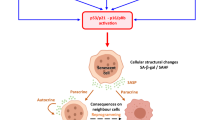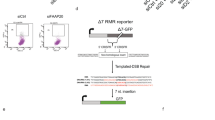Abstract
Fanconi anaemia (FA) is an autosomal-recessive disorder characterized by genomic instability, developmental defects, DNA crosslinking agent hypersensitivity and cancer susceptibility1–3. Somatic-cell hybrid studies have revealed five FA complementation groups (A–E; refs 4–6) displaying similar phenotypes, suggesting that FA genes are functionally related7. The two cloned FA genes, FAA and FAC, encode proteins that are unrelated to each other or to other proteins in GenBank8–10. In the current study, we demonstrate that FAA and FAC bind each other and form a complex. Protein binding correlates with the functional activity of FAA and FAC, as patient-derived mutant FAC (L554P) fails to bind FAA. Although unbound FAA and FAC localize predominantly to the cytoplasm, the FAA–FAC complex is found in similar abundance in both cytoplasm and nucleus. Our results confirm the interrelatedness of the FA genes in a pathway, suggesting the cooperation of FAA and FAC in a nuclear function.
This is a preview of subscription content, access via your institution
Access options
Subscribe to this journal
Receive 12 print issues and online access
$209.00 per year
only $17.42 per issue
Buy this article
- Purchase on Springer Link
- Instant access to full article PDF
Prices may be subject to local taxes which are calculated during checkout
Similar content being viewed by others
References
Alter, B.P. & Young, N.S. in Hematology of Infancy and Childhood, 4th ed., Vol. 1. (eds Nathan D.G. & Oski F.A.) 216–316 (W.B. Saunders, Philadelphia, 1993).
Fanconi, G. Familial constitutional panmyelocytopathy, Fanconi's anemia (FA). I: Clinical aspects. Semin. Hematol. 4, 233–240 (1967).
Liu, J., Buchwald, M., Walsh, C.E. & Young, N.S. Fanconi anemia and novel strategies for therapy. Blood. 84, 3995–4007 (1994).
Buchwald, M. Complementation groups: one or more per gene. Nature Genet. 11, 228–230(1995).
Strathdee, C.A., Duncan, A.M.V. & Buchwald, M. Evidence for at least four Fanconi anaemia genes including FACC on chromosome 9. Nature Genet. 1, 196–198(1992).
Joenje, H. et al. Classification of Fanconi anemia patients by complementation analysis: evidence for a fifth genetic subtype. Blood. 86, 2156–2160 (1995).
D'Andrea, A.D. Fanconi anaemia forges a novel pathway. Nature Genet. 14, 240–242(1996).
Strathdee, C.A., Gavish, H., Shannon, W.R. & Buchwald, M. Cloning of cDNAs for Fanconi's anaemia by functional complementation. Nature. 356, 763–767 (1992).
Lo Ten Foe, J.R. et al. Expression cloning of a cDNA for the major Fanconi anaemia gene, FAA . Nature Genet. 14, 320–323 (1996).
Apostolou, S. et al. Positional cloning of the Fanconi anaemia group A gene. Nature Genet. 14, 324–328 (1996).
Gavish, H., dos Santos, C.C. & Buchwald, M. A Leu554-to-Pro substitution completely abolishes the functional complementing activity of the Fanconi anemia (FACC) protein. Hum. Mol. Genet. 2, 123 (1993).
Yamashita, T., Barber, D.L., Zhu,Y., Wu, N. & D'Andrea, A.D. The Fanconi anemia polypeptide FACC is localized to the cytoplasm. Proc. Natl. Acad. Sci. USA 91, 6712–6716(1994).
Youssoufian, H. Localization of Fanconi anemia C protein to the cytoplasm of mammalian cells. Proc. Natl. Acad. Sci. USA 91, 7975–7979 (1994).
Yamashita, T. et al. Clinical variability of Fanconi anemia (type C) results from expression of an amino terminal truncated Fanconi anemia complentation group C polypeptide with partial activity. Blood. 87, 4424–4432 (1996).
Legerski, R. & Peterson, C. Expression cloning of a human DNA repair gene involved in xeroderma pigmentosum group C. Nature 359, 70–73 (1992).
van Vuuren, A.J. et al. Evidence for a repair enzyme complex involving ERCC1 and complementing activities of ERCC4, ERCC11 and xeroderma pigmentosum group. F. EMBOJ. 12, 3693–3701 (1993).
Youssoufian, H., Li, Y., Martin, M.E. & Buchwald, M. Induction of Fanconi anemia cellular phenotype in human 293 cells by overexpression of a mutant FAC allele. J. Clin. Invest. 97, 957–962 (1996).
Papavassiliou, A.G., Treier, M., Chavrier, C. & Bohmann, D. Targeted degradation of c-Fos, but not v-Fos, by a phosphorylation-dependent signal on c-Jun. Science. 258, 1941–1944 (1992).
Shual, K. et al. Polypeptide signalling to the nucleus through tyrosine phosphorylation of Jak and Stat proteins. Nature. 366, 580–583 (1993).
Kupfer, G.M. et al. The Fanconi anemia protein, FAC, binds to the cyclin-dependent kinase, cdc2. Blood. 90, 1047–1054 (1997).
Ory, D., Neugeboren, B. & Mulligan, R. A stable human-derived packaging cell line for production of high-titer retrovirus/vesicular stomatitis virus G pseudo types. Proc. Natl, Acad. Sci. USA. 93, 11400–11406 (1996).
Roehm, N.W., Rodgers, G.H., Hatfield, S.M. & Glasebrook, A.L. An improved colorimetric assay for cell proliferation and viability using the tetrazolium salt XTT. J. Immunol. Methods. 142, 257–265 (1996).
Whitney, M. et al. Microcell mediated chromosome transfer maps the Fanconi anaemia group D gene to chromosome 3p. Nature Genet. 11, 341–343 (1995).
Author information
Authors and Affiliations
Rights and permissions
About this article
Cite this article
Kupfer, G., Näf, D., Suliman, A. et al. The Fanconi anaemia proteins, FAA and FAC interact to form a nuclear complex. Nat Genet 17, 487–490 (1997). https://doi.org/10.1038/ng1297-487
Received:
Accepted:
Issue Date:
DOI: https://doi.org/10.1038/ng1297-487
This article is cited by
-
A case report and literature review of Fanconi Anemia (FA) diagnosed by genetic testing
Italian Journal of Pediatrics (2015)
-
CHK1 inhibition as a strategy for targeting fanconi anemia (FA) DNA repair pathway deficient tumors
Molecular Cancer (2009)
-
FANCG promotes formation of a newly identified protein complex containing BRCA2, FANCD2 and XRCC3
Oncogene (2008)
-
Emergence of a DNA-damage response network consisting of Fanconi anaemia and BRCA proteins
Nature Reviews Genetics (2007)
-
A novel Leu153Ser mutation of the Fanconi anemia FANCD2 gene is associated with severe chemotherapy toxicity in a pediatric T-cell acute lymphoblastic leukemia
Leukemia (2007)



